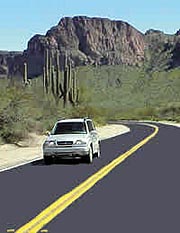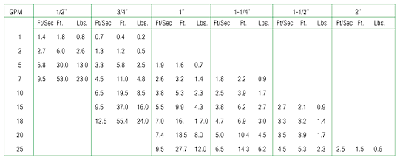

The faster water in a pumped system flows, the higher the pressure loss.
-
The viscosity of the fluid. Viscosity is the measure of a fluid’s resistance to flow. The higher the viscosity, the more pressure it takes to push it through a pipe. Molasses is harder to pump than water, but since we only are considering water systems in this article, all the tables and factors presented here are calculated for the viscosity of water.
-
The smoothness of the inside of the pipe. A pipe that is coated with calcium deposits and rust will cause more pressure drop than a clean, smooth pipe. The accompanying tables are for new, smooth pipe, so if your water has high calcium content, which will cause the pipes in your system to be coated with deposits, increase the pressure drop in your calculations by 20 percent.
-
The inside diameter of the pipe. For a given flow rate, the smaller the pipe, the greater the pressure loss.
-
The flow rate or velocity of the fluid. The faster it flows, the higher the pressure loss.
- The number of valves and fittings in the system. When a fluid has to change direction or flow through an irregular object, more pressure is lost than when it flows through a straight section of pipe. The amount of flow restriction for valves and fittings is expressed in terms of equivalent lengths of pipe.

Table 1. Equivalent lengths of fittings.

Table 2. Velocity in feet per second and pressure drop in feet of head and PSI per 100 feet of copper pipe.
Pressure Loss in Pipes
We commonly speak of friction pressure loss in terms of pressure drop per 100 feet of pipe. Tables depicting pressure drop are called dynamic pressure drop tables because they show the pressure loss due to the moving (dynamic) water through the pipes. The other kind of pressure loss, which we talked about last month, is called static pressure loss, which is the loss due to differing elevations in the system. Table 2 shows pressure loss in terms of feet of head and pounds per square inch, as well as velocity in terms of feet per second for copper pipe. It is important to size your piping system with velocity in mind. The National Hydraulic Institute recommends 7 feet/second as a maximum design velocity for optimum hydraulic efficiency and minimal erosion. As you can see in Table 2, velocity decreases dramatically as pipe size goes up for a given flow rate. Contact your pump or pipe supplier for similar tables for PVC and steel pipe.Next month, we will use this information to calculate the pressure drop in the piping system in a typical residential water system. ’Til then ….


Report Abusive Comment